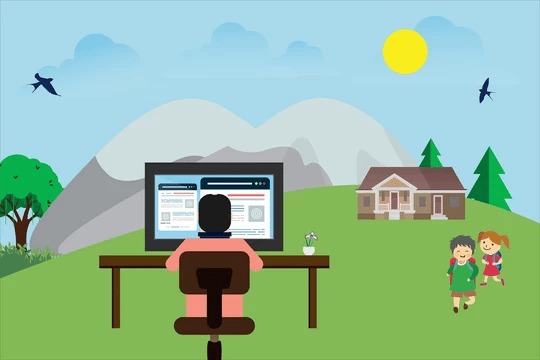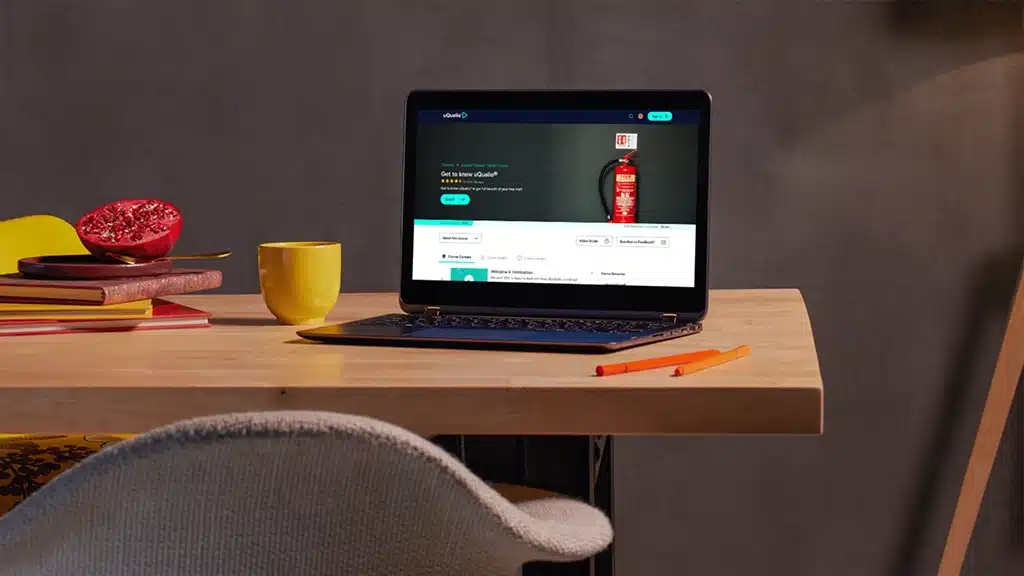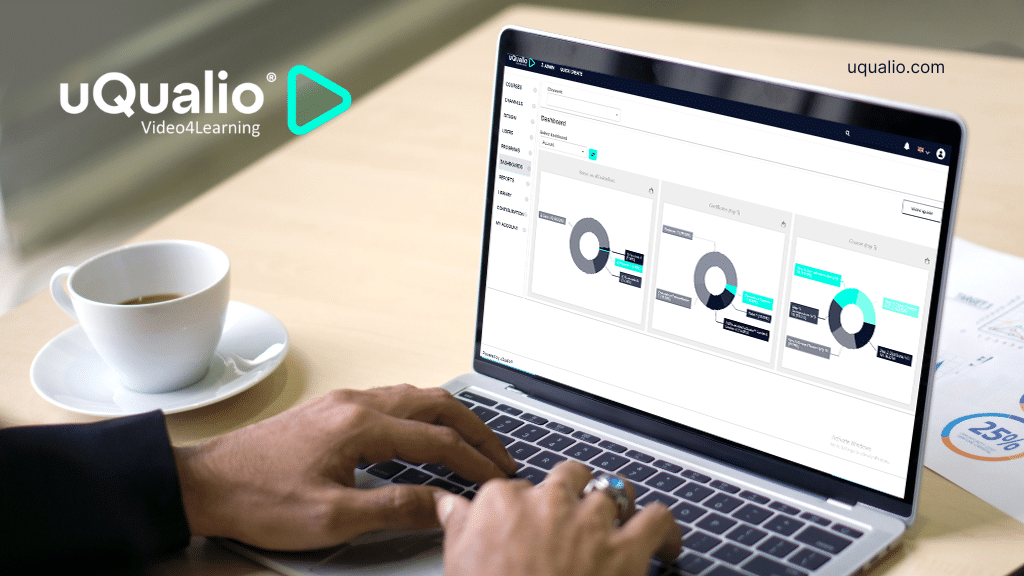Whether you are an entrepreneur, creator, sales, or marketing person, chances are that you have considered running a webinar. It is easy to get overwhelmed by the things you have to do to plan, run and promote a webinar. Learn why and how easy it can be done and how eLearning authoring creation software can help you bite-size your webinar afterward!
A successful webinar can strengthen a company’s brand awareness, increase exposure in the market, and generate qualified sales leads. If done right, it can even elevate an organization’s credibility and reinforce its position as an industry thought leader. According to InsideSales.com, 73% of marketing and sales leaders say webinars are one of the best ways to generate quality leads. And the video recording can afterward be used for endless repurposing possibilities afterward.
However, running a high-profile webinar event can be intimidating and challenging. So we collected the following tips and tricks to help you!
Plan your webinar
Getting your webinar set up and running is all about efficient planning. You have to plan thoroughly if you want your webinar to succeed. You really want to think about how your webinar topic fits in your content, your current lead generation strategy, and what other areas you want to improve. So, when you think about planning at a high level, just drop webinars into your content calendar, give yourself the ramp time to get them done, and remember that it doesn’t have to become overly complicated.
Here are 7 things to add to your checklist:
- Length: Historically, it was expected that a webinar needed to be an hour to 45 minutes, but it could easily be 15 minutes to fit a bite-size microlearning during somebody’s lunch. Do not think from the webinar perspective, but as if you were creating a video. Especially as webinars can be repurposed afterward and shared as a blog, shorter video, or eLearning.
- Time: Preparation time is needed and bother for before, during, and after the webinar itself. When you start with planning, make sure to give yourself an adequate time ramp.
- Style: When it comes to style, you need to think not only about the style of the deck but the style in which you are going to create the webinar. Think about if your webinar should be live or recorded. How much of the webinar should be deck and how much video? Is it going to be a panel or interview style? Presentation style choices are essential and will inform the rest of your planning process.
- Research: This kinda rolls into content strategy in general. As George and Remington mention, sales teams are a great resource for figuring out what are the objections and the information that prospects need to know. You shouldn’t just pick a random topic – people attend webinars to learn. Select what connects with your audience: solving a pain point, sharing how to get better results, or keeping them up to date with industry news.
- Hosts: Pay a lot of attention to who you want to have as the host. Regardless of who you invite, the key is to make sure that the speaker has the proper knowledge and experience. Consider the thought-leaders in the space, who internally and externally are thought leaders. Break a mindset of having only a couple of people in a company presenting a deck and doing a sales pitch in the end. It’s all about creating video content in a webinar format. Also, if you are bringing people in that have a large audience – it’s likely to reach more people.
- Storyboard & Script: You will need some talking points and scripts. But once you start planning the process, storyboarding could come in handy when figuring out how much content you want or need. It might sound like it can get super complicated, but it’s as simple as having a stack of post-it notes or dropping in some bullet points. This can help you with the direction and general content ideas for the slides, instead of starting with the slides and getting lost in all this information you have.
- Location: Always think about your location. Don’t be on a noisy street. And make sure that you are in a space that’s flexible with the lighting.
Prepare your webinar
- Pages. When creating a landing page for your webinar, one of the things you need to consider is the registration form. Keep those forms optimized for conversion by testing the copy. Also, communicate the right information that would entice someone to fill out the form. What is the job title and role of the speakers? When does the webinar start? What’s the background of the topic you’ll be discussing? Use graphics that sell what you are going to talk about. The graphics, the consistency of the brand, and making sure that the visuals thigh into the topic.
- Calls-to-Action. You will need to have CTA’s that can go on your website, via ads on social, via email to your list, so you want to have graphics that are catered to all. One CTA that people tend to forget is the potential for putting webinar promotions to personal signatures to promote this webinar with every single email.
- Deck. You don’t have to do it alone. Meaning, it doesn’t have to be all of your mind, or all of your information, or all of your internal resources, or your shared knowledge as a company. You should leverage things like quotes and stats from the outside.
- Social. What you wanna do is to create some assets, specific to the channel. You can change the cover of your social pages for promotion, you can have short-form videos (less than 2 min) inviting to a webinar; and graphics for social posts or advertisements. Highlight why the webinar is going to be awesome, give some stats to get people teased. Think about how you can create curiosity and drive value.
- Video. You need to create a teaser that is video-based, talking about what you’re going to talk about on a webinar. Some things to mention in a video: CTA to sign up, what you will talk about, who else will be on the webinar (present those thought leaders). The idea is to use it at the top of a blog post or on social channels.
Video-based ads and posts are more likely to generate clicks and traffic to your blog posts, landing pages, or webinar registration page.
Practice, Practice, Practice! Don’t let your great content be ruined by bad delivery. Dry run with your script and deck (even if they’re still in outline form) and any guests you may have before you go live. It will allow you to get familiar with the content, slides and come across as knowledgeable, natural, relaxed, and enunciating clearly. Also, you will understand your time box better.
Test. Practice in presenter mode, don’t just look at the slide deck. A lot of webinar platforms will let you do a practice run, so make sure to test, test, test, l to work through any technical issues before the big day.
Promote your webinar
There are loads of ways to promote your upcoming webinar! From sharing the registration page with your database to social media channels, including recruiting co-hosts in sharing it with their network. In the third P, we give you some ideas on how to best inform people that your webinar is happening.
- Email. Make sure to promote your webinar to your database, addressing the problem statement and deliverables of what people will learn. Make it short, concise, and easy to register. Also, send out reminder emails to the people that didn’t register with the first email and to those that have already registered for your webinar. Since everybody is busy, reminder emails are a must to increase attendance.
- Social. Promoting your webinar on social media is one of the best ways to boost registration. Post about it on your social media channels and get your employees to share information as well. Here, also focus on reminders and posting at different times, especially if you are trying to reach people across the world.
- Signature. All employees across your company could have some type of CTA in their email.
- In-Platform. Let your website visitors know that you’ve got fresh content coming up, whether it’s in a resource hub or learning center.
- Personal Invites. If you have individual people that you want to target, you should have a template that could be 80% written while 20% customizable, allowing you to quickly make your reach outs.
Present your webinar
Time for the big day! Breathe in and show up at your designated location at least a half-hour early. It will give you time to set everything up, run through any issues and quickly review your materials one more time. Check what other things are important to consider before running your webinar below.
Connection. Ensure that you will have great connectivity from wherever you will be doing a webinar. Also, have a plan B in case things go down (We recommend being hardwired in while running a webinar with wifi as a backup plan).
- Location & Equipment. Camera and webcam selection comes first if you are doing a video and it will dictate audio and lighting choices, of course, don’t forget to pick a decent microphone. You are putting on a presentation that should have great video and audio quality.
- Audience. When you are presenting at a physical event, you would ask questions and engage with the audience. Make sure to do the same in the webinar – ask people questions and pause to give them time to respond. You should always encourage people to use the chat panel and the question panel so that you get more engagement – it’s all about the conversation.
- Offline Tools. Have a notepad, pencil, and water. You can make some notes if somebody asks a question and get back to it later.
Publish your webinar
Done? Congrats! Now that the webinar is done, make sure to publish it to make it available for everybody on-demand. Of course, if it’s necessary – first make edits and prepare the video.
- Convert & Measure. Take the webinar and convert it into a video. Hopefully, you have a platform that already does that for you, allowing you to automatically measure the success of the live recording and the recorded version. We found in our State of Webinars report that 59% of marketers lose their engagement & conversion data when hosting their on-demand webinars with services like YouTube, Vimeo, Dropbox, or Google Drive. Use that video data to lead score, to nurture, and to put people to different workflows.
- Update. Pay attention to updating things such as copy on the landing page, changing the CTA’s for the site, and blog for the on-demand webinar. You can also use featured images, take snippets or screenshots of the actual webinar.
- Conversion Points. Consider using video forms for on-demand webinars that reduce friction and play as soon as the form is submitted.
Promote & Plan (Again)
Once you are done with your webinar – you have a video to promote and clip!
- Sharing & Repurposing. Webinars are so valuable because you can cut them up into different pieces – you can turn them into a blog post, you can take a 30-second clip and throw it on social media to engage your audience to go watch the rest of the webinar. Also, after the webinar, you want to send two emails to your audience: one to thank for attending, including a link to the webinar recording, and another for those that didn’t attend.
- Guests & Thought-Leaders. You definitely want to reach out to the guests or thought-leaders. Let them know that the webinar is ready to be promoted again, as an on-demand recording.
- Sales Professionals. Salespeople in your company are starving for content that can help them close deals. And webinars are the perfect piece of content for them to measure how engaged a lead is. You could also send an internal memo to the sales team, describing this new content piece and how it can help them out, sharing some snippets, as well.
- Evergreen Content. Once the video is ready on-demand, it could be used a number of different times in both sales and marketing.
And that’s it. This list can seem overwhelming, but, really, all you have to do to simplify your webinars is to choose the right content for your audience, and team, and go out and organize. It’s not as complicated as it seems at first sight and is incredibly rewarding from a lead and engagement point-of-view.
Achieve Effective & Affordable Video Training
– uQualio is an award-winning, easy-to-use, all-in-one NextGen LMS software for any types of online video training.












